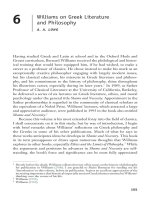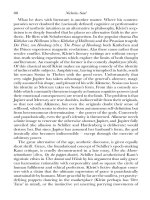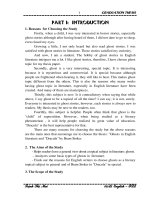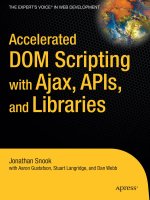Literature and libraries
Bạn đang xem bản rút gọn của tài liệu. Xem và tải ngay bản đầy đủ của tài liệu tại đây (466.35 KB, 104 trang )
Literature and Libraries
LIS413
Brendan A. Rapple
Simmons College
9 July, 2009
Literature
•
Imaginative works having some claim to artistic value, e.g.:
– poetry; legends and folk tales; drama; short stories;
novels.
•
Certain non-fictional works of high artistic quality:
– Literary nonfiction may include almost any writing
except the strictly technical.
•
Don’t Forget Oral Literature!
What is English?
• Is English the language or does it pertain to the
country?
Literary Criticism
•
Literary history: literature is viewed as part of a historical process.
•
Literary theory: an attempt is made to describe the principles of literature,
its genres, and its techniques and functions.
•
Evaluative criticism: concerns the study and analysis of specific works and
their authors.
Curricular Changes
•
“Many of the most publicized changes in higher education in the past three
decades have been curricular. Critics inside and outside academe have wrung
their hands over a variety of course appearances, adjustments, and alleged
"disappearings" (the dirty work of "leftist" faculty hit squads). A major thrust of
most of these curricular reforms was to acknowledge the historical importance
and cultural contributions of groups, doers, and thinkers beyond the limited cast
or "canon" of Western white males featured in prevailing texts and syllabi. This,
in turn, led to the inclusion of women and other "minorities," an emphasis on
conflict and pluralism, a globalization of the curriculum in general, a
questioning of the canonical criteria of "greatness," and a rise in cross- and
interdisciplinary studies. Simultaneously, an influx of "postmodernist" theory
from France and Germany threatened the humanities and social sciences by
overturning or seriously challenging virtually all of their traditional
("modernist") assumptions and intellectual procedures. All of these changes
posed a major threat to the status quo and induced no little angst in the halls of
ivy.”
•
James Axtell. Virginia Quarterly Review (2003)
Literary Criticism Now Less US/Eurocentric
“Literary criticism now investigates entire ranges of literary
production that do not share in Western culture. Critics treat the
writings of poets, playwrights, and novelists, from postcolonial
regions in the Pacific, Caribbean, and South Africa who use pidgin
forms of English and sometimes French to articulate their own
social realities and histories. They also give new attention to
writings and songs from ‘fourth-world’ peoples, that is, from
minorities marginalized in ghettos within first-world cultures.”
Today English Depts. often Provide
courses and programs in
•
literary theory
•
rhetoric and composition
•
technical writing
•
creative writing
•
cultural, TESOL, linguistics, children’s and adolescent literature
•
language arts
•
English education
•
pedagogical theory
•
Computerization of literature
English Studies/Literary Studies is Turning More and
More into Cultural Studies
Criticism of Cultural Studies:
“The downside of the equation between cultural studies and literary studies is
that, carried to its logical conclusion, cultural studies can dispense with the
literary altogether. Studies of consumerism, for example, can be based on the
analysis of shopping malls or Home Depot layouts; no literary texts are required.
Teen culture can be explored through music, film, and computer games. Current
social mores and cultural constraints can be profitably studied by examining
Internet discourse. And so on. Everything, after all, can be a text and so why not
a golf course? A skating rink? A theme park?”
Marjorie Perloff. Crisis in the Humanities
Differences in Collecting Between
•
Public Libraries
•
Academic and Research Libraries (here the acquisition of
literary scholarship, i.e. secondary material, is stressed)
Texts
•
Scholars often concerned with distinguishing the literary work from the
(sometimes many) texts that embody it.
•
A text may be considered a process as well as a finished product.
•
Many aspects:
• Creation of the text
• Production
• Dissemination
• Reception
• Preservation
History of Books and Publishing
Many scholars are concerned “with the agents and process of the production of
texts: . . . progression from manuscript to serial or book; collaboration of author
and editor; distribution and dissemination over time and place; influence of
bookseller, librarian, and teacher; reception by readers who themselves are
influenced in their reading by their own personal histories.” (Day & Wortman,
2000)
“No published text, literary or otherwise, exists in isolation: rather, it is the
collaborative effort of many people -- authors and editors, papermakers and
printers, publishers and readers, among others” (Winship, 1995)
Reception and Reading
•
Scholars may study how a book was received, reviewed etc.
•
Many “book review” print and online indexes available
•
However, it’s much harder to know what ordinary readers think
•
Still sales figures may be indicative
•
Reviews on Amazon.com
•
Reading habits/interests of writers easier to locate:
–
–
–
–
–
–
–
Personal libraries
Library borrowing records
Journal/diary entries
Published reviews
Teaching
Comments in letters
Etc.
Parameters of Texts
•
Can a text be more than words?
•
e.g.
•
•
•
•
Sound
Video
Computer graphics
Web content
• BeeHive Hypertext /Hypermedia Journal: http://
beehive.temporalimage.com/departments/
• Electronic Literature Collection:
What is Hamlet?
•
There are three versions of Hamlet probably written by Shakespeare.
•
There are countless scholarly and popular versions
•
How many professional (and amateur) dramatic versions for stage,
screen, radio, television, and classroom? Multitudes!
Manga Shakespeare
How Important is the Medium?
•
"The context cannot but condition the process. Screen and book may exhibit the
same string of words, but the assumptions that underlie their significance are
entirely different depending on whether we are staring at a book or a circuitgenerated text.”
Sven Birkerts
•
“. . . the possibilities offered by digitization increase the number of collections
accessible from a distance but also reinforce the idea that there is an equivalence
between media and that a text is still the same regardless of its form: printed,
microfilmed, or digital. That notion is fundamentally wrong because the
processes through which a reader attributes meaning to a text depend,
consciously or not, not only on the semantic content of the text, but also on the
material forms through which the text was published, distributed, and received.”
Roger Chartier, Languages, Books, and Reading from the Printed Word to the Digital Text
The Evolving Book
•
The book, that paper medium, product of a dated technique, has become a
reductive matrix that we have to reform; to let go of the linearity and the fixity of
its pages, to allow text to reveal itself by other means, in other contexts with
other possibilities of expression”
Jean-Pierre Balpe, 2004
Any Reactions To . . . ?
•
Minority of authors specify how their words will appear on the page.
•
Reading the text for content, and not an examination of the physical
nature of the artifact, is why most scholars consult books.
•
For most a facsimile of the printed book is a perfectly acceptable
alternative to the original copy.
•
Different ways to access authored content:
– Read
– Hear
Kinds of Texts
•
Manuscripts: handwritten, typed, or word-processed texts that precede printed, published
texts -- often drafts.
•
Original Editions: first and other eds. (in author’s lifetime) whose form of publication is
authorized by author.
•
Subsequent Editions: many types.
•
Scholarly Editions: texts of works that have been determined by editor(s) to have some
degree of authority (based on manuscript, original, and subsequent editions).
•
Student Editions: usually have a sound text; an introduction to the historical and literary
contexts; content annotations; might also have a selection of critical articles or author’s
letters etc.
•
Anthologies
Electronic Texts
•
Some are quite basic – just the text.
•
Some e-texts are typed, some are scanned.
•
OCR (optical character recognition) is often used.
•
Increasingly PDF is used.
•
Sometimes HTML markup language is used.
Added Value to Texts
•
•
•
•
•
•
•
•
Scholarly essays
Biographical materials
Annotations
Timelines
Bibliographies
Images
Sound
Video etc.
Hypertext Fiction
•
Disappearing Rain by Deena Larsen
•
Reach, a fiction, The Iowa Review Online, Spring 2000.
/>
Online Novels
• Free Online Novels
/>









